|
March 1961 Popular Electronics
 Table of Contents Table of Contents
Wax nostalgic about and learn from the history of early electronics. See articles
from
Popular Electronics,
published October 1954 - April 1985. All copyrights are hereby acknowledged.
|
Having worked on S-band
and X-band radar as a maintenance technician for a four-year hitch in the U.S.
Air Force, articles like this one from a 1961 issue of Popular Electronics
magazine always piques my interest. A lot of ground is covered here regarding
some history on documented cases of unintentional human exposure to microwaves
and laboratory experiments on animals exposed to microwave radiation. Author Ken
Gilmore points out the difference between ionizing radiation from nuclear
actions and reaction, and non-ionizing radiation from microwave generators. In
today's political environment, facilities in Ukraine, China (Wuhan in
particular), etc., would need to be secretly paid to do the animal experiments
described herein. Some pretty incredible scenarios are described where radar
technicians would stand in front of radiating antennas to keep themselves warm
in cold climates, and one guy would stick his hand into an antenna horn to check
whether the transmitter was on by noting if his hand got warm (probably causing
a wickedly high VSWR on the output amplifier). A lot of similar research has
been performed on radio frequency effects on humans since the advent of
cellphone operating in the
UHF and into
S-band regions. The term "specific
absorption rate" (SAR) has become common parlance in the industry since the
mid-1990's. This is a good historical read.
The Truth About the Danger of Radar Waves - Exclusive Report
What Is This Man Wearing?
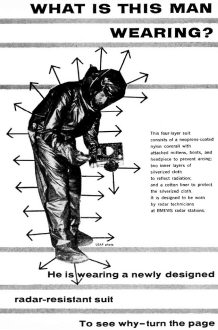
He is wearing a newly designed radar-resistant suit.
This four-layer suit consists of a neoprene- coated nylon coverall
with attached mittens, boots, and headpiece to prevent arcing; two inner layers
of silverized cloth to reflect radiation; and a cotton liner to protect the silverized
cloth. It is designed to be worn by radar technicians at BMEWS radar stations.
By Ken Gilmore
Shortly after radar was introduced during World War II, rumors about its dangerous
side effects swept through the armed services. Men working around radar, the story
went, would never have children.
The rumors were officially denied and discredited, and eventually the furor died
down. Everyone became so complacent, in fact, that until a few years ago it was
common practice for men working around radar in cold climates to stand directly
in the beam to warm themselves.
Recently we've been hearing again that radar waves are dangerous. The armed services
and industries which manufacture, test, or operate radar and other powerful microwave
equipment are going to a lot of trouble to keep workers away from the business end
of high -powered microwave transmitters.
With such shifts in opinion and attitudes over the years, it is no wonder that
many people are confused. And the continued circulation of claims, counter not helped.
Less than two years ago, for example, a popular national news magazine reported
that a radar technician had been killed by radar. True or false? To this day, not
even the experts agree.
When it was announced that a powerful radar station would be installed in northern
England as part of our Ballistic Missile Early Warning System, a storm of protest
broke loose. British newspapers, citizens groups, and individuals claimed that the
mammoth transmitter would do everything from killing people in the area to frying
bees and thus ruining agriculture by preventing pollination of crops.
Adding to the general misunderstanding, microwave radiation has become widely
confused in the public mind with ionizing radiation. The fact is, the two are completely
unrelated. Microwave radiation - the kind we are talking about - is energy generated
by radar and other electronic equipment operating roughly between 200 and 30,000
megacycles. Ionizing radiation, on the other hand, is produced by radioactive materials
and X-ray machines - it is the radiation we think of in connection with atom bombs,
fallout, and the Van Allen radiation belt.
But what of microwave radiation? Is it dangerous, too? Should
experimenters, hams, and others working with high-frequency electronic equipment
be very careful?

To make this Thule, Greenland, radar installation safe for the
men who operate it, special passageways (visible at the lower right) were constructed.
The peak r.f. power radiated exceeds 10,000,000 watts.
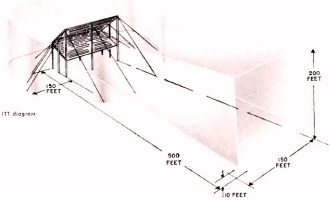
The "danger areas" near a huge corner reflector used for scatter
communications are shown in color. Operating personnel are warned to stay out of
these areas.
Although much remains to be learned, intensive research over the past few years
has pretty well answered these questions. Summarized briefly, here is what we now
know about microwave radiation and the way it can affect us:
- Microwave radiation definitely can affect human tissue and cause damage.
- Only high-powered equipment, usually found either in military or industrial
service, generates radiation sufficiently intense to be harmful to anyone.
- Even this high-powered equipment, if its hazards are understood and proper
precautions taken, can be used in complete safety and confidence.
- And, most surprising, recent research indicates that microwaves, under certain
conditions, can have beneficial effects that may some day be used in the treatment
of disease.
Heat Causes the Trouble
Microwaves can cause damage by generating heat in human tissue. Diathermy machines
used by doctors apply this heat-generation principle in a controlled way. It also
accounts for the fact that technicians can stand in radar beams and get warm. But
this is a mighty dangerous way to chase a chill. Recent experiments show why.
Not long ago, scientists at the National Institute of Neurological Diseases put
monkeys directly in the output beam of a 200-watt u.h.f. transmitter operating at
various frequencies between 225 and 400 mc. In each case the animals were dead within
five minutes. The diagnosis : death by "hyperthermia" excessive internal temperature.
In further experiments, rats, mice, and other animals have proved that microwaves
can kill.
Man, of course, can take more. His heat-regulating system is far more effective
than those of the lower animals. So he can absorb far more microwave radiation and
get rid of the heat. But there is a limit.
Have microwaves actually killed anyone? Scientists do not agree.
About four years ago, a 42-year-old radar technician in Glendale, California,
was working about ten feet in front of a radar antenna. He felt a sensation of warmth
in his abdomen, and moved quickly away. Nevertheless, he was taken ill a few minutes
later. Doctors rushed him to a hospital and found he had a ruptured appendix. He
was operated on, but shortly afterwards went into shock and died a few days later.
The doctor in charge diagnosed the case as death from exposure to microwave radiation.
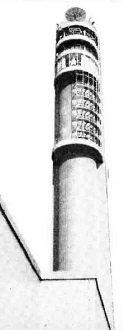
This ITT tower in Nutley, N. J., is used for microwave experiments.
To prevent the possibility of dangerous radiation, a trapdoor interlock shuts down
the transmitters whenever a technician goes on the roof to service the antennas.
But many questions remained. One frankly skeptical Air Force doctor, also an
expert in the field of microwave radiation, asked: "Why have thousands of men worked
with the same or more powerful radars without even minor injury or discomfort, let
alone fatal consequences ?"
Many authorities feel that the man died from the results of his ruptured appendix,
the operation, shock, or a combination of the three. The case remains unsettled.
Microwaves and the Eyes
Although the danger is clearly present, cases of actual injury from radiation
are hard to find. One doctor in Albuquerque, New Mexico, reported that a patient
of his developed cataracts from exposure to microwave energy. The technician was
in the habit of shoving his hand into a microwave horn to see if the transmitter
was operating. If his hand got warm, the power was on.
In making this check, he had to look into the horn, and thus also put his eyes
directly in the beam. One day, after spending a longer than normal time at work,
he found that he could not see clearly. His doctor diagnosed the difficulty as several
small cataracts resulting from r.f. radiation.
Can r.f. really cause cataracts? Tests with animals show conclusively that it
can. Rabbits, whose eyes are very much like human eyes, have developed cataracts
after exposure to intense radiation.
Tests have shown, as a matter of fact, that the eyes are the body's most radiation-
sensitive organs, since they have the poorest heat dissipation system in the body.
Elsewhere, blood circulation and perspiration can quickly get rid of excess heat.
But our eyes tend to retain it and get hotter and hotter until damage is done.
Other Strange Effects
Next to the eyes, the most radiation-sensitive organs are the testes. Excessive
exposure to microwave radiation, can, as the old rumors had it, make a man sterile.
But the situation is not as bad as it seems: the effect is only temporary. Sperm
cells are extremely sensitive to heat. Thus, those already manufactured by the body
may be killed by a temperature rise of only a few degrees. But radiation does not
interfere with the body's ability to make more sperm cells. One researcher in the
field estimates that a dose of radiation strong enough to permanently sterilize
a man would also probably kill him.
All radiation damage to experimental animals so far noted is attributable to
the effects of heating. But scientists have recently noted other strange effects
that seem to have nothing to do with heat. Researchers at the University of Miami,
for example, exposed chickens to a radar beam too weak to kill them. At certain
frequencies the chickens began to stagger, lose control of their muscles, and turned
off, they recovered immediately. Rats reacted the same way.
No one is certain why this strange behavior takes place, but here's the best
theory devised to explain it so far. At certain frequencies, signals apparently
resonate with certain nerve paths, or the spinal cord, "short-circuiting" the normal
electrical signals the brain sends the muscles to control them. The case clearly
points up the fact that there are still many unanswered questions about how microwaves
affect us.
Safety Pays Off
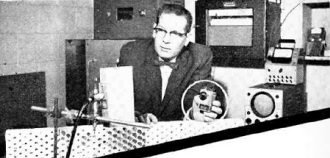
A dosimeter developed by Dr. A. W. Richardson of Saint Louis
University is used to measure r.f. radiation. Worn by a maintenance technician,
it sounds an audible tone when r.f. intensity becomes dangerous.
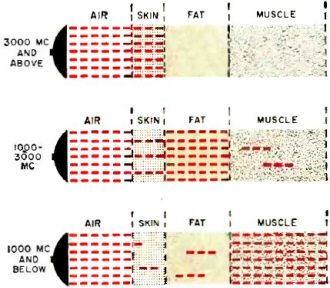
Frequency determines whether r.f. will be absorbed or reflected
by outer layers of skin. As shown here, r.f. from about 200 to 1000 mc. is most
dangerous -it penetrates the muscles and internal organs.
The fact that only two known cases of death or injury have been reported in this
country - and even these are not confirmed - is testimony to the fact that adequate
precautions are being taken where hazards exist. Air Force scientists at Rome Air
Force Development Center have concluded that no microwave damage of any kind has
ever been observed unless the experimental animal was absorbing at least 0.2 watt
of microwave energy for every square centimeter of surface area. To put it another
way, to be in danger, they had to absorb more than a watt per square inch of exposed
skin.
Since 0.2 watt/sq.cm. is the danger level for animals, and man can probably
stand more, the Air Force plays it extra safe by specifying that personnel shall
be exposed to radiation fields no greater than one-twentieth that amount, or 0.1
watt/sq.cm.
Most companies observe the same standards but a few are even more conservative.
Operators of the Distant Early Warning radar network which stretches across northern
Canada, for example, have set 0.001 watt/sq.cm. - one-tenth as much as the Air
Force - as the exposure limit.
Industry and the armed services go to great lengths to protect personnel from
radiation exceeding these limits. International Telephone and Telegraph Company,
for example, interlocks all dangerous areas. The radar antenna on top of the ITT
tower in urban Nutley, N. J., is not dangerous from the ground - but it would be
from the radar platform. So the trap door on the roof leading to the antenna is
interlocked: open the trap door and you automatically kill the antenna power.
BMEWS Protection System
Undoubtedly the most elaborate preventive measures ever taken are now in effect
at the Air Force's BMEWS station in Thule, Greenland. Its huge radars put out pulses
of microwave energy at the incredible power level of ten million watts.
The transmitter building is especially shielded to protect technicians from the
tremendous radiation. The covered passageways are also solidly shielded-ceiling,
walls, even floors - so that crews can go from one building to the other with the
radars in operation.
Shielding of the buildings and passageways presented quite a few problems during
construction. Even though the walls were made of galvanized steel sheeting, too
much radiation energy got through. So first all joints were welded to eliminate
cracks. Then, two layers of copper screen were added inside where necessary. And
this was topped off in particularly troublesome spots with concrete.
Even small holes in the screen let in too much radiation. Every one of them had
to be patched and soldered. Special ventilators that would let in air but not radiation
had to be designed and tested.
With all buildings carefully shielded only one more serious problem remained.
Sub-zero temperatures and howling arctic blizzards are prevalent during winter
in Greenland. No equipment can stand up forever under such punishment, and outside
repairs must be made from time to time. The problem was to figure out a way to make
repairs without turning off the radar or cooking the personnel.
The answer: radiation suits designed and built by the Wright Air Development
Command especially for BMEWS workers. With this modern-day armor, technicians are
able to work safely in r.f. fields that would kill an unprotected man in minutes.
Beneficial Uses
While most of the problems of protecting electronic workers from radiation have
now been pretty well solved, scientists are vitally aware that there is a great
deal they don't know about radiation and its biological effects. But this knowledge
gap is fast being bridged. Both military and civilian scientists are pressing forward
at top speed trying to unravel a few of the mysteries still surrounding the subject.
At the Fourth Annual Tri-Service Microwave Conference held in New York last summer,
researchers made some startling disclosures. Lt. Col. Sven A. Bach of the Army Medical
Research Laboratory in Fort Knox, Kentucky, for example, told how he had discovered
a "profound molecular change" in human gamma globulin which had been subjected to
microwave radiation at certain frequencies. Said Bach, the gamma globulin molecules
showed "at least a fourfold increase in biological activity."
What does this mean to you? Gamma globulin plays an important part in the body's
defenses against disease. Speed up its activity fourfold and it may be four times
as effective a disease fighter. Some day your doctor may give you "a shot of microwave"
to keep you well.
Dr. Joe Howland of the University of Rochester found that dogs which had been
exposed to microwaves were able to withstand heavy doses of X-rays far better than
dogs not so treated. No specific application for this technique is now known, but
such discoveries frequently lead to undreamed-of advances.
And, finally, some evidence has been gathered to indicate that certain kinds
of cells, under the right conditions, will simply disintegrate - fly to pieces - in
the presence of the right radiation. But surrounding cells are unaffected. Could
such a selective beam ever be used to destroy cancer cells while leaving healthy
tissue unaffected? Scientists don't yet know.
Said Col. George M. Knauf, one of the foremost experts on the biological effects
of microwaves, speaking of these recent advances, "Our work has progressed sufficiently
for us to be fairly certain that the beneficial uses to which this energy may be
put will greatly outweigh any harmful results it may produce in men."
All this, of course, does not mean we should forget that uncontrolled microwave
energy can be dangerous. But like fire or X-rays, microwaves can, when used intelligently
and with understanding and respect for the hazards involved, be among man's most
valuable tools.
Posted September 21, 2022
|


































